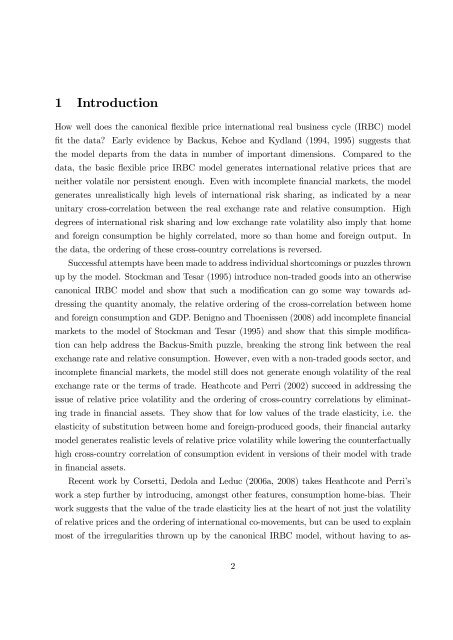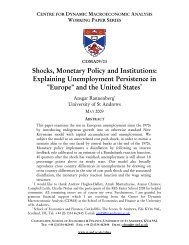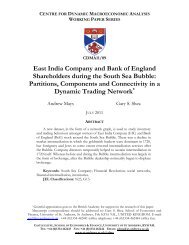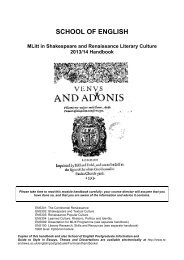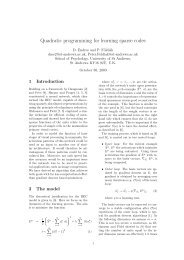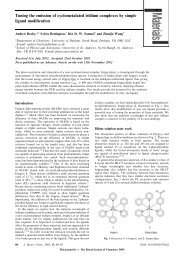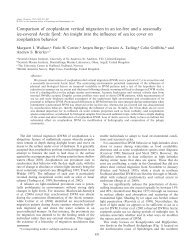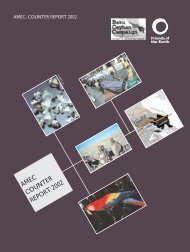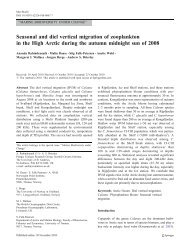Exchange rate dynamics, asset market structure and the role of the ...
Exchange rate dynamics, asset market structure and the role of the ...
Exchange rate dynamics, asset market structure and the role of the ...
Create successful ePaper yourself
Turn your PDF publications into a flip-book with our unique Google optimized e-Paper software.
1 Introduction<br />
How well does <strong>the</strong> canonical ‡exible price international real business cycle (IRBC) model<br />
…t <strong>the</strong> data? Early evidence by Backus, Kehoe <strong>and</strong> Kydl<strong>and</strong> (1994, 1995) suggests that<br />
<strong>the</strong> model departs from <strong>the</strong> data in number <strong>of</strong> important dimensions. Compared to <strong>the</strong><br />
data, <strong>the</strong> basic ‡exible price IRBC model gene<strong>rate</strong>s international relative prices that are<br />
nei<strong>the</strong>r volatile nor persistent enough. Even with incomplete …nancial <strong>market</strong>s, <strong>the</strong> model<br />
gene<strong>rate</strong>s unrealistically high levels <strong>of</strong> international risk sharing, as indicated by a near<br />
unitary cross-correlation between <strong>the</strong> real exchange <strong>rate</strong> <strong>and</strong> relative consumption. High<br />
degrees <strong>of</strong> international risk sharing <strong>and</strong> low exchange <strong>rate</strong> volatility also imply that home<br />
<strong>and</strong> foreign consumption be highly correlated, more so than home <strong>and</strong> foreign output. In<br />
<strong>the</strong> data, <strong>the</strong> ordering <strong>of</strong> <strong>the</strong>se cross-country correlations is reversed.<br />
Successful attempts have been made to address individual shortcomings or puzzles thrown<br />
up by <strong>the</strong> model. Stockman <strong>and</strong> Tesar (1995) introduce non-traded goods into an o<strong>the</strong>rwise<br />
canonical IRBC model <strong>and</strong> show that such a modi…cation can go some way towards addressing<br />
<strong>the</strong> quantity anomaly, <strong>the</strong> relative ordering <strong>of</strong> <strong>the</strong> cross-correlation between home<br />
<strong>and</strong> foreign consumption <strong>and</strong> GDP. Benigno <strong>and</strong> Thoenissen (2008) add incomplete …nancial<br />
<strong>market</strong>s to <strong>the</strong> model <strong>of</strong> Stockman <strong>and</strong> Tesar (1995) <strong>and</strong> show that this simple modi…cation<br />
can help address <strong>the</strong> Backus-Smith puzzle, breaking <strong>the</strong> strong link between <strong>the</strong> real<br />
exchange <strong>rate</strong> <strong>and</strong> relative consumption. However, even with a non-traded goods sector, <strong>and</strong><br />
incomplete …nancial <strong>market</strong>s, <strong>the</strong> model still does not gene<strong>rate</strong> enough volatility <strong>of</strong> <strong>the</strong> real<br />
exchange <strong>rate</strong> or <strong>the</strong> terms <strong>of</strong> trade. Heathcote <strong>and</strong> Perri (2002) succeed in addressing <strong>the</strong><br />
issue <strong>of</strong> relative price volatility <strong>and</strong> <strong>the</strong> ordering <strong>of</strong> cross-country correlations by eliminating<br />
trade in …nancial <strong>asset</strong>s. They show that for low values <strong>of</strong> <strong>the</strong> trade elasticity, i.e. <strong>the</strong><br />
elasticity <strong>of</strong> substitution between home <strong>and</strong> foreign-produced goods, <strong>the</strong>ir …nancial autarky<br />
model gene<strong>rate</strong>s realistic levels <strong>of</strong> relative price volatility while lowering <strong>the</strong> counterfactually<br />
high cross-country correlation <strong>of</strong> consumption evident in versions <strong>of</strong> <strong>the</strong>ir model with trade<br />
in …nancial <strong>asset</strong>s.<br />
Recent work by Corsetti, Dedola <strong>and</strong> Leduc (2006a, 2008) takes Heathcote <strong>and</strong> Perri’s<br />
work a step fur<strong>the</strong>r by introducing, amongst o<strong>the</strong>r features, consumption home-bias. Their<br />
work suggests that <strong>the</strong> value <strong>of</strong> <strong>the</strong> trade elasticity lies at <strong>the</strong> heart <strong>of</strong> not just <strong>the</strong> volatility<br />
<strong>of</strong> relative prices <strong>and</strong> <strong>the</strong> ordering <strong>of</strong> international co-movements, but can be used to explain<br />
most <strong>of</strong> <strong>the</strong> irregularities thrown up by <strong>the</strong> canonical IRBC model, without having to as-<br />
2


